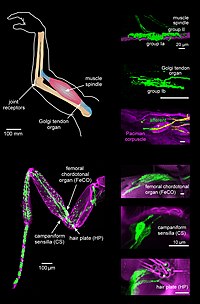
Photo from wikipedia
BACKGROUND Diastasis recti abdominis (DRA) affects a significant number of women in the postpartum period. OBJECTIVE This study compared the effectiveness of suspension training system (STS) with that of isometric-isotonic… Click to show full abstract
BACKGROUND Diastasis recti abdominis (DRA) affects a significant number of women in the postpartum period. OBJECTIVE This study compared the effectiveness of suspension training system (STS) with that of isometric-isotonic (ISoM-ISoT) exercises in the treatment of DRA and its secondary complications. METHODS Thirty-six women with DRA participated in this study. They were divided into the three groups of STS, ISoM-ISoT, and control. Inter-recti distance (IRD), proprioception, lumbopelvic control, postural stability, low back pain, and disability were assessed using a digital caliper, a goniometer, a lateral step-down test, a Biodex balance system, a visual analogue scale (VAS), and the Oswestry Disability Index (ODI), respectively. Two intervention groups underwent training for 8-week and the control group resumed their normal lives. RESULTS Positive effects were observed in the STS and ISoM-ISoT groups compared with the control group in: IRD (P = .001); lumbopelvic proprioception (P = .001); lumbopelvic control (P = .001); overall static balance (P = .010); overall dynamic balance (P = .012); low back pain (P = .001); and disability (P = .001). However, there was no significant difference between the training groups in: IRD (P = .12, MD = -2.76); lumbopelvic proprioception (P = .48, MD = -0.50); lumbopelvic control (P = .14, MD = 1.53); static balance (P = .62, MD = 0.07); dynamic balance (P = .27, MD = 0.33); pain (P = .25, MD = -0.52); and disability (P = .48, MD = -1.74). The results of the minimal clinically important difference (MCID) and minimal detectable change (MDC) suggested that the STS exercises outperformed ISoM-ISoT training regarding IRD, pain, disability, and proprioception, whereas ISoM-ISoT training had a better effect in lumbopelvic control and balance. CONCLUSION The results of our study showed that the STS had a positive effect on women with DRA and like the ISoM-ISoT exercises can be used to treat this dysfunction.
Journal Title: Physiotherapy theory and practice
Year Published: 2022
Link to full text (if available)
Share on Social Media: Sign Up to like & get
recommendations!